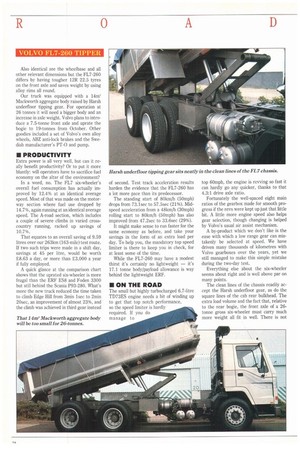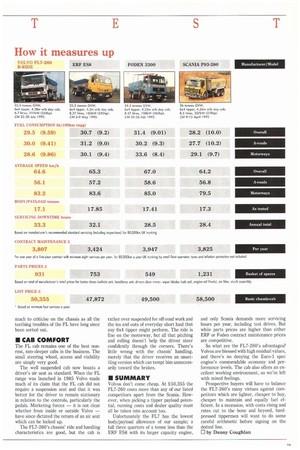Also identical are the wheelbase and all other relevant dimensions
Page 30

Page 31

If you've noticed an error in this article please click here to report it so we can fix it.
but the FL7-260 differs by having tougher 12R 22.5 tyres on the front axle and saves weight by using alloy rims all round.
Our truck was equipped with a 14m3 Mackworth aggregate body raised by Harsh underfloor tipping gear. For operation at 26 tonnes it will need a bigger body and an increase in axle weight. Volvo plans to introduce a 7.5-tonne front axle and uprate the bogie to 19-tonnes from October. Other goodies included a set of Volvo's own alloy wheels, ABZ anti-lock brakes and the Swedish manufacturer's PT-0 and pump.
Extra power is all very well, but can it really benefit productivity? Or to put it more bluntly: will operators have to sacrifice fuel economy on the altar of the environment?
In a word, no. The FL7 six-wheeler's overall fuel consumption has actually improved by 12.4% at an identical average speed. Most of that was made on the motorway section where fuel use dropped by 14.7%, again running at an identical average speed. The A-road section, which includes a couple of severe climbs in varied crosscountry running, racked up savings of 10.7%.
That equates to an overall saving of 9.59 litres over our 263km (163-mile) test route. If two such trips were made in a shift day, savings at 45 per litre, would be worth £8.63 a day, or more than £3,000 a year if fully employed.
A quick glance at the comparison chart shows that the uprated six-wheeler is more frugal than the ERF ES8 and Foden 3300 but still behind the Scania P93-280. What's more the new truck reduced the time taken to climb Edge Hill from 3min lsec to 2min 20sec, an improvement of almost 23%, and the climb was achieved in third gear instead of second. Test track acceleration results harden the evidence that the FL7-260 has a lot more pace than its predecessor.
The standing start of 80km/h (50mph) drops from 73.1sec to 57.5sec (21%). Midspeed acceleration from a 48km/h (30mph) rolling start to 80km/h (50mph) has also Unproved from 47.2sec to 33.6sec (29%).
It might make sense to run faster for the same economy as before, and take your savings in the form of an extra load per day. To help you, the mandatory top speed limiter is there to keep you in check, for at least some of the time.
While the FL7-260 may have a modest thirst it's certainly no lightweight — it's 17.1 tonne body/payload allowance is way behind the lightweight ERF.
The small but highly turbocharged 6.7-litre TD73ES engine needs a bit of winding up to get that top notch performance, so the speed limiter is hardly required. If you do manage to top 60mph, the engine is revving so fast it can hardly go any quicker, thanks to that 4.3:1 drive axle ratio.
Fortunately the well-spaced eight main ratios of the gearbox made for smooth progress if the revs were kept up just that little bit. A little more engine speed also helps gear selection, though changing is helped by Volvo's usual air assist mechanism.
A by-product which we don't like is the ease with which a low range gear can mistakenly be selected at speed. We have driven many thousands of kilometres with Volvo gearboxes over the years, yet we still managed to make this simple mistake during the two-day test.
Everything else about the six-wheeler seems about right and is well above par on many points.
The clean lines of the chassis readily accept the Harsh underfloor gear, as do the square lines of the cab rear bulkhead. The extra load volume and the fact that, relative to the rear bogie, the front axle of a 26tonne gross six-wheeler must carry much more weight all fit in well. There is not much to criticise on the chassis as all the teething troubles of the FL have long since been sorted out.
The FL cab remains one of the best nonrest, non-sleeper cabs in the business. The small steering wheel, access and visibility are simply very good, The well suspended cab now boasts a driver's air seat as standard, When the FL range was launched in 1985 Volvo made much of its claim that the FL cab did not require a suspension seat and that it was better for the driver to remain stationary in relation to the controls, particularly the pedals. Marketing forces it is not clear whether from inside or outside Volvo have since dictated the return of an air seat which can be locked up.
The FL7-260's chassis' ride and handling characteristics are good, but the cab is
rather over suspended for off-road work and the ins and outs of everyday short haul that any 6x4 tipper might perform. The ride is fine on the motorway, but all that pitching and rolling doesn't help the driver steer confidently through the corners. There's little wrong with the chassis' handling, merely that the driver receives an unsettling version which can tempt him unnecessarily toward the brakes.
Volvos don't come cheap. At £50,355 the FL7-260 costs more than any of our listed competitors apart from the Scania. However, when picking a tipper payload potential, running costs and dealer quality must all be taken into account too.
Unfortunately the FL7 has the lowest body/payload allowance of our sample; a full three quarters of a tonne less than the ERF ES8 with its larger capacity engine, and only Scania demands more servicing hours per year, including test drives. But while parts prices are higher than either ERF or Foden contract maintenance prices are competitive.
So what are the FL7-260's advantages? Volvos are blessed with high residual values, and there's no denying the Euro-1 spec engine's commendable economy and performance levels. The cab also offers an excellent working environment, so we're left with mixed feelings.
Prospective buyers will have to balance the FL7-260's many virtues against competitors which are lighter, cheaper to buy, cheaper to maintain and equally fuel efficient. In a recession, with costs rising and rates cut to the bone and beyond, hardpressed tippermen will want to do some careful arithmetic before signing on the dotted line.
















































































